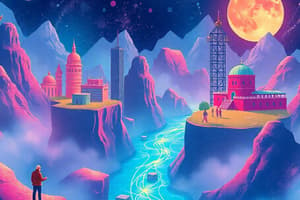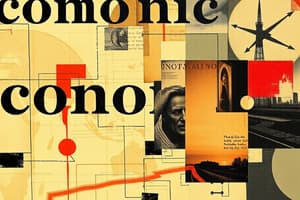Podcast
Questions and Answers
What is the main objective of economics related to the distribution of income or GDP among members of society?
What is the main objective of economics related to the distribution of income or GDP among members of society?
Economic justice
According to the concept of economics, which approach defines economics as the study of how people interact to trade goods and services?
According to the concept of economics, which approach defines economics as the study of how people interact to trade goods and services?
- The Satisfaction of Human Needs Approach
- The Wealth Approach
- The Scarcity Approach
- The Exchange Approach (correct)
Economics is defined as the science of accumulating wealth and its exchange, among other perspectives.
Economics is defined as the science of accumulating wealth and its exchange, among other perspectives.
False (B)
Production is the process of transforming economic resources into consumable goods and ___.
Production is the process of transforming economic resources into consumable goods and ___.
Match the economic concept with its description:
Match the economic concept with its description:
What are the types of consumption mentioned in the content?
What are the types of consumption mentioned in the content?
Define consumption.
Define consumption.
What is the definition of saving?
What is the definition of saving?
______ refers to the reduction in the value of fixed assets over time due to wear, tear, obsolescence.
______ refers to the reduction in the value of fixed assets over time due to wear, tear, obsolescence.
Match the type of investment with the correct definition:
Match the type of investment with the correct definition:
Banks are legally required to be licensed by the government.
Banks are legally required to be licensed by the government.
Define frictional unemployment.
Define frictional unemployment.
What is cyclical unemployment?
What is cyclical unemployment?
Hidden unemployment occurs as a result of non-economic factors.
Hidden unemployment occurs as a result of non-economic factors.
Which type of unemployment occurs as a result of structural changes in the economy?
Which type of unemployment occurs as a result of structural changes in the economy?
Match the type of inflation with its characteristics:
Match the type of inflation with its characteristics:
___________ unemployment occurs due to technological progress.
___________ unemployment occurs due to technological progress.
Define demand-pull inflation.
Define demand-pull inflation.
What is one of the causes of inflation related to wage increases?
What is one of the causes of inflation related to wage increases?
Hyperinflation can lead to a significant loss of value by the currency.
Hyperinflation can lead to a significant loss of value by the currency.
Suppressed inflation occurs in the presence of government controls on the prices of goods and services, which artificially curb the rise in prices, leading to the emergence of shortages in goods and services and the spread of the ______ economy.
Suppressed inflation occurs in the presence of government controls on the prices of goods and services, which artificially curb the rise in prices, leading to the emergence of shortages in goods and services and the spread of the ______ economy.
Study Notes
The Concept of Economics
- Economics is a social science that studies how to manage scarce resources to meet unlimited human needs and wants.
- There are several approaches to define economics:
- Wealth approach: Economics is the science of wealth, focusing on its accumulation, production, and distribution.
- Satisfaction of human needs approach: Economics is the science of satisfying human needs, which are diverse and changing.
- Exchange approach: Economics is the study of exchange, which involves the trade of goods and services.
- Scarcity approach: Economics is the science of managing scarce resources to meet multiple goals and needs.
Objectives of Economics
- The main objectives of economics are:
- Efficiency: Optimal use of economic resources.
- Economic growth: Increase in the amount of goods and services produced by society over time.
- Economic stability: Price stability and the absence of abnormal fluctuations in the general price level.
- Economic justice: Equitable distribution of income or output among members of society.
Types of Economic Analysis
- There are two types of economic analysis:
- Microeconomics: Studies the economy at the level of individual units, such as households and firms.
- Macroeconomics: Studies the economy as a whole, focusing on aggregate variables like GDP, inflation, and unemployment.
Economics and Other Sciences
- Economics is related to other social sciences, such as sociology, political science, and psychology.
- Economics also draws on natural sciences, such as mathematics and statistics.
The Economic Problem
- The economic problem is the fundamental challenge of satisfying unlimited human needs and wants with limited economic resources.
- The economic problem is characterized by scarcity, choice, sacrifice, and opportunity cost.
Determinants of the Economic Problem
- Economic needs: Essential goods and services that people need for survival.
- Economic resources: Factors of production, such as labor, land, capital, and management.
Solving the Economic Problem
- In a capitalist system, the economic problem is solved through the price mechanism, which balances supply and demand.
- In a socialist system, the economic problem is solved through collective ownership and central planning.
Contemporary Economic Systems
- Capitalist economic system:Characterized by private ownership of the means of production, free markets, and competition.
- Socialist economic system:Characterized by public ownership of the means of production, central planning, and social equality.
Production and Consumption
- Production: The process of transforming economic resources into consumable goods and services.
- Types of production: Industrial, service, and agricultural production.
- Importance of production: Meets needs, creates jobs, increases national income, and leads to economic development.
Savings and Investment
- Savings: The portion of current income not spent on consumption, allocated to building productive capacity.
- Importance of savings: Capital accumulation, economic growth, enhancing future income, and financial strength.
- Factors affecting savings: Income level, interest rates, inflation, economic growth, and psychological and social factors.
Investment
- Investment: The act of using money now to generate more money in the future.
- Types of investment: Domestic, foreign, real, and financial investment.
- Importance of investment: Increased productivity, national income, job creation, and improved infrastructure.
National Income and Its Relationship to GDP, GNP, and NNP
- GDP: Total output inside the country.
- GNP: Total output inside and outside the country by its own residents.
- NNP: GDP minus the depreciation of assets.
- NI: Income received by all country residents inside or outside the country.
Economic Agents and the Mechanism of Income Flow
-
Economic agents: Individuals or organizations that make up the economy, such as households, firms, government, and foreigners.
-
The economic cycle: The regular ups and downs in economic activity, consisting of depression, recovery, prosperity, and recession phases.### Market and Economics
-
A market is an area where supply and demand meet, either directly or indirectly, and can be physical or virtual.
-
Types of markets include:
- Goods and Services Market: where goods and services are bought and sold.
- Labor Market: where labor is bought and sold.
- Financial Market: where financial assets, such as stocks, bonds, and securities, are bought and sold.
Money and Banks
- Money is a generally accepted medium of exchange that serves several functions in an economy:
- Measures the value of goods and services
- Facilitates exchange
- Stores value
- Functions as a medium of payment
- Characteristics of money:
- Durability
- Portability
- Divisibility
- Fungibility
- Scarcity
- Banks are financial institutions that deal with money, accepting deposits, making loans, and facilitating various financial transactions.
- Characteristics of banks:
- Legally recognized
- Profit-making
- Central role in the economy
- Types of banks:
- Central banks: oversee the monetary system and regulate commercial banks.
- Commercial banks: provide a wide range of services to individuals and businesses.
- Investment banks: specialize in helping businesses raise capital through investments and financial markets.
- Islamic banks: adhere to Islamic Sharia principles.
- Agricultural banks: specialize in providing banking services to farmers.
Unemployment
- Definition of unemployment: a person who is capable of work, willing to work, and actively seeking work but unable to find employment.
- Types of unemployment:
- Frictional unemployment: a natural result of market processes taking time and information being costly.
- Cyclical unemployment: occurs as a result of cyclical changes in economic activity.
- Structural unemployment: occurs as a result of structural changes in the economy, such as technological change or changes in the demand for labor.
- Hidden unemployment: occurs as a result of non-economic factors, such as lack of job opportunities.
- Technical unemployment: occurs as a result of technological progress.
- Seasonal unemployment: occurs as a result of seasonal changes in demand for labor.
- Part-time unemployment: occurs when a person works less than the hours of work they want or need.
- Imported unemployment: occurs as a result of international trade.
- Psychological unemployment: occurs as a result of psychological and emotional factors.
- Causes of unemployment:
- Recession
- Technology
- Trade
- Government policies
- Skills mismatch
- Demographics
- Labor market rigidities
- Personal choices
- Natural disasters
- Political instability
- Effects of unemployment on the economy:
- Reduced output and consumption
- Loss of tax revenue
- Increased government spending
- Skill erosion
- Wage pressures
- Long-term negative impact
- Increased crime rates
- Reduced social mobility
- Negative psychological impact
- Solutions to unemployment:
- Encourage youth entrepreneurship
- Provide accurate information about the labor market
- Reform the education system
- Link educational and economic institutions
- Retrain redundant labor
- Review wage policy
- Encourage entrepreneurs to create job opportunities
- Develop the agricultural sector
- Benefit from the experiences of other countries
Inflation
- Definition of inflation: a sustained increase in the general price level of goods and services in an economy over a period of time.
- Types of inflation:
- Creeping inflation: a gradual and slow rise in prices
- Stagflation: a faster rise in prices, leading to a noticeable erosion of the purchasing power of money
- Hyperinflation: a rapid and uncontrolled rise in prices, leading to the loss of significant value by the currency
- Open inflation: occurs in the presence of economic imbalances, such as a shortage of production or an increase in demand
- Suppressed inflation: occurs in the presence of government controls on the prices of goods and services
- Hidden inflation: occurs when the government imposes strict controls on prices
- Causes of inflation:
- Demand-pull inflation: when the total demand for goods and services in an economy exceeds the available supply
- Cost-push inflation: when the total supply of goods and services in the economy that can be produced falls
- Wage increases
- Money issuance
- Lack of stability
- Impact of inflation:
- Decreased purchasing power
- Redistribution of wealth
- Higher interest rates
- Reduced investment
- Economic policies to treat inflation:
- Fiscal policies:
- Cutting government spending
- Raising taxes
- Wage freeze policy
- Monetary policies:
- Raising interest rates
- Open market policy (Selling assets)
- Reducing the money supply
- Increasing reserve requirements
- Fiscal policies:
Studying That Suits You
Use AI to generate personalized quizzes and flashcards to suit your learning preferences.
Description
This quiz covers the concept of economics, its definition, and its relationship with other sciences, including the wealth approach, satisfaction of human needs approach, and exchange approach.




